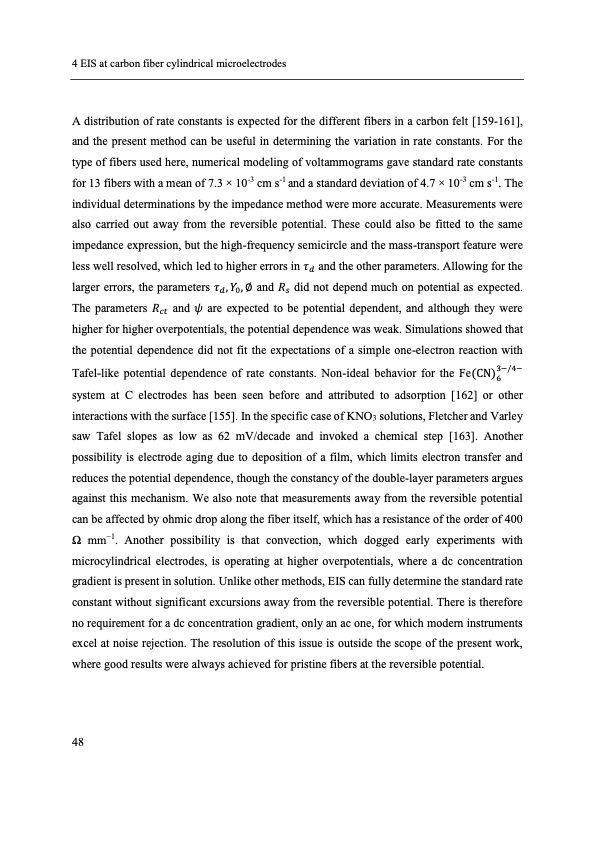
PDF Publication Title:
Text from PDF Page: 060
4 EIS at carbon fiber cylindrical microelectrodes A distribution of rate constants is expected for the different fibers in a carbon felt [159-161], and the present method can be useful in determining the variation in rate constants. For the type of fibers used here, numerical modeling of voltammograms gave standard rate constants for 13 fibers with a mean of 7.3 × 10-3 cm s-1 and a standard deviation of 4.7 × 10-3 cm s-1. The individual determinations by the impedance method were more accurate. Measurements were also carried out away from the reversible potential. These could also be fitted to the same impedance expression, but the high-frequency semicircle and the mass-transport feature were less well resolved, which led to higher errors in 𝜏𝑑 and the other parameters. Allowing for the larger errors, the parameters 𝜏 , 𝑌 , ∅ and 𝑅 did not depend much on potential as expected. 𝑑0𝑠 The parameters 𝑅𝑐𝑡 and 𝜓 are expected to be potential dependent, and although they were higher for higher overpotentials, the potential dependence was weak. Simulations showed that the potential dependence did not fit the expectations of a simple one-electron reaction with Tafel-like potential dependence of rate constants. Non-ideal behavior for the Fe(CN)3−/4− 6 system at C electrodes has been seen before and attributed to adsorption [162] or other interactions with the surface [155]. In the specific case of KNO3 solutions, Fletcher and Varley saw Tafel slopes as low as 62 mV/decade and invoked a chemical step [163]. Another possibility is electrode aging due to deposition of a film, which limits electron transfer and reduces the potential dependence, though the constancy of the double-layer parameters argues against this mechanism. We also note that measurements away from the reversible potential can be affected by ohmic drop along the fiber itself, which has a resistance of the order of 400 Ω mm−1. Another possibility is that convection, which dogged early experiments with microcylindrical electrodes, is operating at higher overpotentials, where a dc concentration gradient is present in solution. Unlike other methods, EIS can fully determine the standard rate constant without significant excursions away from the reversible potential. There is therefore no requirement for a dc concentration gradient, only an ac one, for which modern instruments excel at noise rejection. The resolution of this issue is outside the scope of the present work, where good results were always achieved for pristine fibers at the reversible potential. 48PDF Image | Electron Transfer Kinetics in Redox Flow Batteries

PDF Search Title:
Electron Transfer Kinetics in Redox Flow BatteriesOriginal File Name Searched:
electron-transfer-flow-batteries-thesis.pdfDIY PDF Search: Google It | Yahoo | Bing
Salgenx Redox Flow Battery Technology: Salt water flow battery technology with low cost and great energy density that can be used for power storage and thermal storage. Let us de-risk your production using our license. Our aqueous flow battery is less cost than Tesla Megapack and available faster. Redox flow battery. No membrane needed like with Vanadium, or Bromine. Salgenx flow battery
| CONTACT TEL: 608-238-6001 Email: greg@salgenx.com | RSS | AMP |